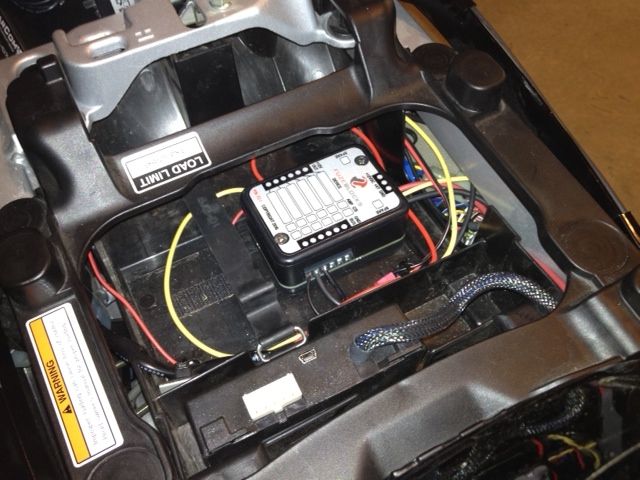Shagomatic
Active member
For those that are interested... I figured out how to post a picture.

Shag

Shag


I bought spool bulk 12 or 14 wire and heat resilient sleeves and ran it all from the battery back. That bundle holds my hot and ground from battery to power it. Then GPS, TPM, electrified tank bag Moto lights, hot to PC V and ground to battery, and electric gear plugs, Givi AddMore light kit, and I forget what else.Where did you get those fancy wires?I bought this bracket from a forum member that goes under the rear seat. FuzeBlock used.I would think location is up to the DIYer. It's not the where, but the how that what I like.

I also used a Centech on my BMW. I like the FuzeBlock as well and the bonus of having a circuit hot at all times if I want.
For those running the fuzeblock, what did you guys do for a wire harness to the battery? Cyclenyz sells one but its 35 bucks....seems pricey given that the relay is part of the block and not the wire harness...
Fred, while I won't disagree that under ideal conditions a 10 ga. can carry 50 amps for a very short distance or low ambient temps, and given that many wire charts can be conflicting or confusing, I'd never play that close to those limits even though could in a low risk environment. Given the environment, wire length, etc., and worst case continuous load of heated gear, aux. lights, I prefer to not take wire gauge to the limits. One such calculator from Blue Sea says 25 amps for fixed load, 6 feet, 2% drop, engine compartment, can run 12 ga. but anything more than that, 10 ga.... That might be slightly conservative, but my preference. YMMV.Nope. Just move all the fuses over to the "constant" position and it still works like any other fuse panel. If you want it switched you can add an external relay at that time. But I have yet to hear of a FuzeBlock that had a failed relay. Just follow the manufacturers recommendations about maximum load current (they advise splitting the load switched and unswitched).I guess I didnt look that close at it...Thats very cool!although if the relay goes then I need to buy a whole new fuzeblock?
Of course, any decent MacGyver would know that you can use a 10 gauge feeder if you really want to. You can just pull a few strands out at the FB end. Yeah, that little spot in the wire will not be 10 gauge anymore, but the entire rest of the length will be, and it's the cumulative resistance over the length that you are concerned with.I'm have the Universal panel from Electrical Connection. I like the 10 ga. feed as the FZ1 only has 12 ga. Everything is switched via the relay, and only my GPS has constant power.
https://www.electrica...plate-02202.htm
Of course all of this is pretty much overkill anyway as 10 gauge wire is rated for 55 amps, and 12 gauge is rated for 41 amps. If you are drawing more than 574 watts of accessories power through your FuzeBlock then you are definitely going to have certain other problems. :huh:
edit - Oh yeah, the bike shop tech is apparently an electrical 'tard. When you add accessories wired direct off the battery none of that additional current goes through the key switch. So that is what they should be encouraging you to do.
Fred, while I won't disagree that under ideal conditions a 10 ga. can carry 50 amps for a very short distance or low ambient temps, and given that many wire charts can be conflicting or confusing, I'd never play that close to those limits even though could in a low risk environment. Given the environment, wire length, etc., and worst case continuous load of heated gear, aux. lights, I prefer to not take wire gauge to the limits. One such calculator from Blue Sea says 25 amps for fixed load, 6 feet, 2% drop, engine compartment, can run 12 ga. but anything more than that, 10 ga.... That might be slightly conservative, but my preference. YMMV.
https://circuitwizard.bluesea.com/
Man, I've pinched a finger and incurred some cuts while doing an install but damn, that's rough. I think you must have been doing something wrong if that happened while doing it....since I had a broken neck, broken right arm, broken right ankle, and 3 broken ribs as I was doing it...
Enter your email address to join: